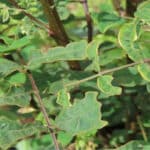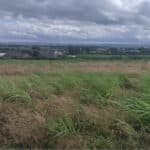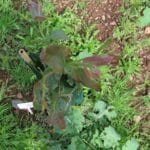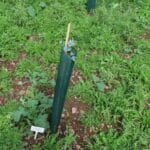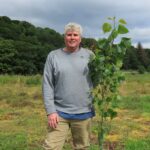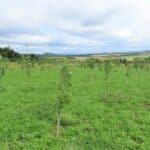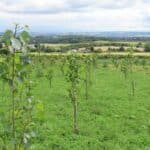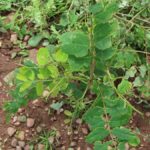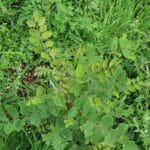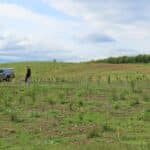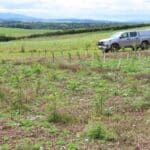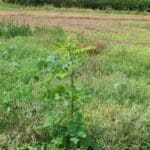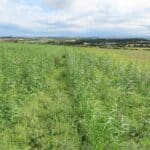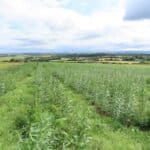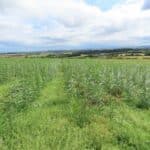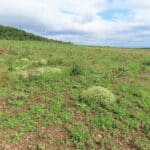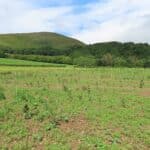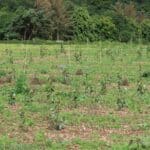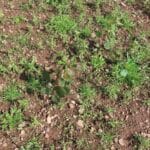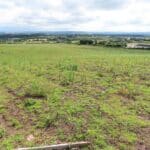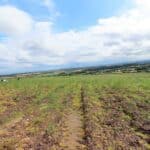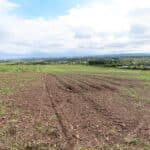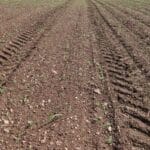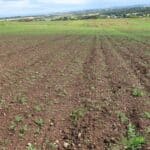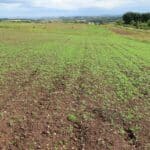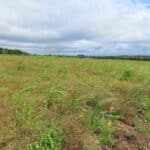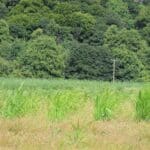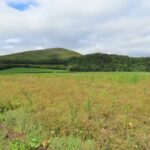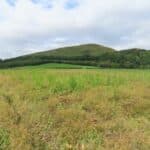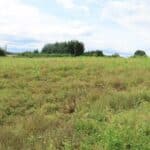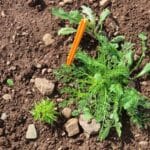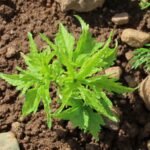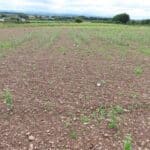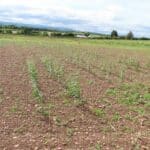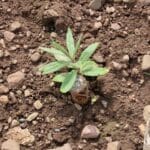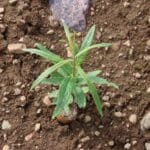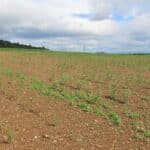August 2023 – Hub Site Update
It has been quite a wet August, warm and very very windy.
Observations from the different plant plots
- The SRF Alder is growing well. So well, that it is probably being restricted by the tree guards?
- The Black Locust Turbo is doing OK. It is growing slowly and has some insect damage.
- The Black Locust Obelisk is not doing well at all – There is a very low emergence rate so far.
- The SRF Poplar is growing very well and is now very tall. There are a couple of snapped trees but these have bounced back.
- The SRF Eucalyptus is mixed. The Eucalyptus denticulata is growing tall whilst other varieties are still smaller than the height of the tree guards.
- Our SRC Poplar Trees remain quite small. They are growing well but are not as tall as the SRF Poplar.
- The SRC Willow is growing very well.
- The Miscanthus MxG is growing very well. There is a patch of couch grass visible that we will need to hand rogued out.
- In the grasses demo plot the large sida rhizomes have appeared and are growing well. The small sida rhizomes seem to be struggling to emerge.
- Most SRC Willow Variety Trial varieties are growing well. A post-emergence herbicide application is planned but TBC.
- The Miscanthus Variety Trial is somewhat patchy. Some varieties are very dense, others not so.
In general, the main weeds are mayweed/pineapple weed, fumitory, OSR/charlock. Some black aphids have been observed on some varieties in the Willow variety trial. There have been quite a lot of craneflies. No obvious diseases have been detected
- Insect damage to Black Locust ‘Turbo’ leaf. Plant does not seem too affected by it.
- Weeds appear to be dying off in Miscanthus Variety Trial.
Weed and Pest Control
All plots have had a pre-emergence spray. Most have had a post-emergence spray too, but the Willow variety trial and grass demo trial post-emergence sprays are TBC.
Corridors and paths have been topped and had glysophate applied. Thistles were manually weeded from SRC Willow and miscanthus variety trial.
Although it has been quite wet, strimming and hand weeding could still be performed and have been ongoing to control weeds.
Hub Site Visit to Boghall
The Biomass Connect Hub Site Coordinators from Rothamsted Research paid a visit on 3rd August. The following are extracts from their report: (Note, some of the recommendations below have now been carried out during August by the team at SRUC Boghall).
It was interesting to see how the planting that was undertaken over the last few months was doing after some extremes in weather conditions during May, June, and July.
In general, inter-row weed control would be beneficial to the trees across the site. A strim and or mow to reduce the height of the weeds and a follow-up Glysophate spray if weather conditions allow will help. The team have been putting in a lot of effort on the weed control, however, it is obvious that some weather and ground conditions have made this quite the task.
The odd deer has been seen making its way across the Biomass Connect site, but no grazing has been observed. The electric fences have been removed at Boghall to allow for tractor topping and spraying to be completed. These will be going back up once tractor work was completed.
SRF Eucalyptus
The Eucalyptus plug plants were planted on the 5th and 6th of May, with tree guards being put on after planting was completed. Overall, establishment among the Eucalyptus varieties looked good. Some varieties appeared to have had better growth rates than others but that is to be expected with some going to fare better in some parts of the UK than others. The ongoing problem across all sites seen to date is weed control. The weeds are not as big in comparison to the Auchincruive site, but they still need tackling. Some mowing has been carried out at Boghall; however, it could benefit from some inter-row Glysophate spraying. Eucalyptus Renewables have highlighted that weed grasses can be very detrimental to the growth rate of the young Eucalyptus plants. The team are also keeping an eye out for any of the ‘Leader’ branches from the plants bursting through the mesh tree guards which was another potential issue highlighted by Eucalyptus Renewables.
- This E. denticulata variety looks to be doing well. There was concern for this variety as they did not appear that healthy at time of planting.
- This E. gunnii variety looks to be doing well, poking nicely over the tree guard.
SRF Poplar
The SRF Poplar that were planted on the 12th of April are looking to be establishing well. Some of the A4A variety have died, without any leaf coverage. As you approach the Boghall site from the road, the Poplar come into view as you climb the hill, they look great, standing out from the rest of the landscape. The picture above does show Glysophate spray taking effect on the weeds that surround the plots which is great. SRUC Boghall have been using the Herbidome for the inter-row spraying. This is working well and hopefully when weather conditions allow, they can get on top of the weeds. With two sites to manage weed control is a big job though.
- SRF Poplar. B. Flannery next to a healthy-looking specimen.
- SRF Poplar Looking good at Boghall
- SRF Poplar looking good. Some of the variety A4A appear to have died with no leaf growth present.
Black Locust ‘Turbo Obelisk’
Out of the two Black Locust varieties, the ‘Turbo Obelisk’ is struggling a little. These were planted on the 12th of April using the ‘T-notch’ technique. Plants that are growing appear much smaller than the ‘Turbo’ variety. Like most of the hub sites are reporting, the drought conditions after planting may have had some impact on the establishment. Also, the weed flush once the rains did come could be having some competition factor with the plants.
Ongoing weed control is necessary. If time allows, it may be best to do the smaller plants by hand. However, if the strimmer/mower operator is confident enough to not accidentally take out the plants, this would be the quicker option. The application of the Glysophate via the Herbidome would really help suppress the weeds to give the plants the best chance of a good growth rate.
There is some pest damage to the leaves. A small blue coloured beetle was spotted on the odd plant on this visit which will be monitored.
- Insect damage to Black Locust ‘Turbo’ leaf. Plant does not seem too affected by it.
- Black Locust Turbo Obelisk at Boghall
- BL ‘Turbo Obelisk’. Plants would benefit from weed control.
Black Locust ‘Turbo’
The ‘Turbo’ variety of Black Locust looks much bigger in height and appears healthier than the ‘Turbo Obelisk’. As the pictures below show, the plants are establishing the thorns associated with the species. These were also planted on the 12th of April, using the Auger, due to the large roots that the plants had when delivered.
It was good to see inter-row strimming being carried out by an SRUC employee during the visit. After a week or two of strimming/mowing, a follow-up with the Herbidome would be ideal to get on top of the weeds. No pest damage to leaves or stems was noticed, however, this should be monitored going forward.
- ‘Turbo’. Strimming around plants being undertaken.
- Black Locust ‘Turbo’ at Boghall
- Black Locust Turbo’. N.B. Thorns are present on the stem.
SRF Common Alder
The Alder establishment looked overall good. Again, these were planted on the 12th of April. The plot is a lot cleaner regarding the weed population. This is ideal and shows the benefit of strimming/mowing the weeds, then allowing the weeds to grow back a bit to increase the surface area for the uptake of the herbicide. A couple of passes with the Herbidome with a Glysophate mix will help suppress the weeds. A return to spot spray here amongst the Alder would be recommended.
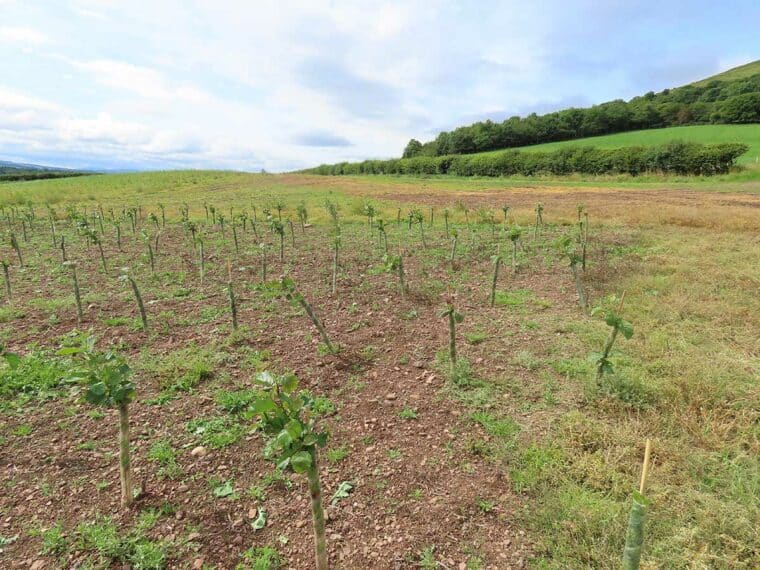
Common Alder and tree guards. N.B. Good weed control and herbicide taking effect on the weeds in the surrounds judging by the ‘yellowing’ off.
SRC willow 0.5 ha area
The willow looks good, and establishment looks great with no gaps spotted. The inter-row weeds could benefit from a strim. We have found the wheeled strimmer ideal for this job. It would be worthwhile to remove the large thistles that are present within the rows of willow (see photo below) to stop them from spreading across the plots.
The product Laser could potentially be used as a post-emergent herbicide if grass weed becomes predominant.
- SRC Willow Plot at Boghall
- SRC Willow Plot at Boghall
- SRC Willow Plot at Boghall
SRC Poplar
The Poplar was planted on the 28th of April. The rows of Poplar seemed in a better condition and establishment numbers looked better than the site in Ayrshire. Weeds in the pictures below would benefit from a herbicide as they are not so big as to require a strim first. The site would benefit from getting the electric fencing up as there is concern that these could be grazed by Hare/Rabbit.
- SRC Poplar at Boghall. N.B. Weeds are starting to get away a bit.
- SRC Poplar at Boghall
- SRC Poplar at Boghall
- SRC Poplar at Boghall
Miscanthus Giganteus 0.5 ha area
The Miscanthus Giaganteus looks to be establishing well. A post-emergent spray was applied and some ‘yellowing off’ can be seen in the photos. Once tractor work has been completed, the electric fence should be put back in place to help prevent any Hare/Rabbit damage.
- Miscanthus giganteus
- Miscanthus giganteus
Miscanthus Athena 0.5 ha area
The Miscanthus ‘Athena’ at Boghall was planted in the first week of July. The establishment does not look great seeing as the rhizomes have been in the ground for a month. A weed flush is starting to emerge. If weather and ground conditions permit, a post-emergence spray may be able to be applied.
- Miscanthus athena plot at Boghall.
- Miscanthus athena plot at Boghall.
- Miscanthus athena plot at Boghall.
- Miscanthus athena plot at Boghall.
Miscanthus 2023 Variety Trial
SRUC Boghall was chosen to host the 2023 Miscanthus variety trial. The plots that were growing overall looked healthy. There were some plots that looked a little sparse though.
- Miscanthus 2023 Variety Trial at SRUC Boghall
- Miscanthus 2023 Variety Trial at SRUC Boghall
- Miscanthus 2023 Variety Trial at SRUC Boghall
- Miscanthus 2023 Variety Trial at SRUC Boghall
- Miscanthus 2023 Variety Trial at SRUC Boghall
Sida
The Sida was couriered up to SRUC on the 10th of July and the team were able to plant a few days later. Checks had been made but they had not been seen to emerge. However, after seeing the photo that the BGI team sent, the definitive shade of green of the Sida could be seen at Boghall too. The few that had emerged were from the bigger rhizome.
- Sida starting to emerge
- Close up of Sida
SRC Willow variety Trial
Generally, the trial is establishing well, except for the gaps where the ECC genotypes that were T-notch planted (due to their time in customs and cuttings rooting). Weeds need to be monitored and controlled, but as you can see from the photos below, the plot is relatively clean. Graminicide Laser could be considered to control grass weeds. The Herbidome could also be deployed to conduct careful inter-row spraying. Nettles and docks should be spot-treated with the Herbidome, preferably before they get too big.
- SRC Willow variety trial at SRUC Boghall
- SRC Willow variety trial at SRUC Boghall
- ne of the EEC cuttings that has sprouted, but small growth in comparison to the other varieties.
- SRC Willow variety trial
- SRC Willow variety trial at SRUC Boghall
